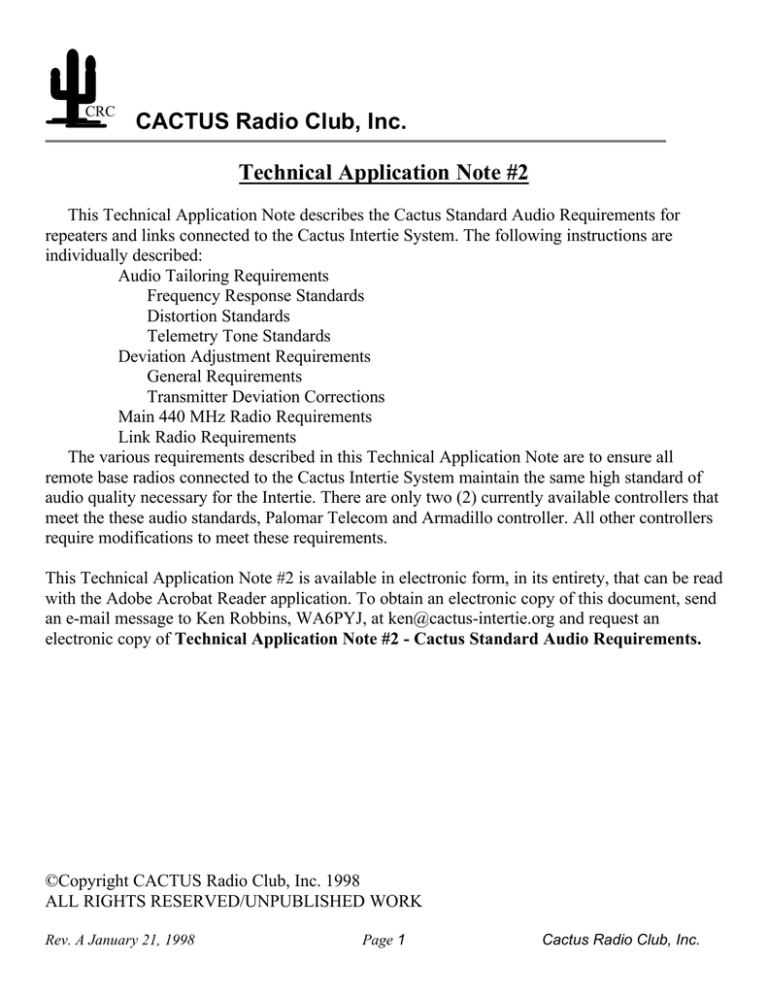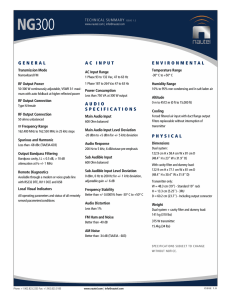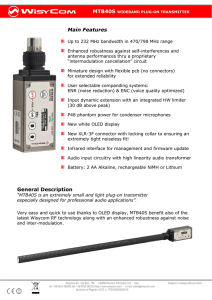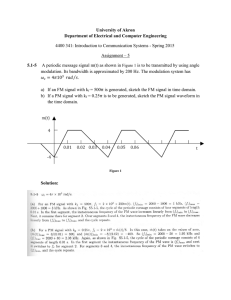
CRC
CACTUS Radio Club, Inc.
Technical Application Note #2
This Technical Application Note describes the Cactus Standard Audio Requirements for
repeaters and links connected to the Cactus Intertie System. The following instructions are
individually described:
Audio Tailoring Requirements
Frequency Response Standards
Distortion Standards
Telemetry Tone Standards
Deviation Adjustment Requirements
General Requirements
Transmitter Deviation Corrections
Main 440 MHz Radio Requirements
Link Radio Requirements
The various requirements described in this Technical Application Note are to ensure all
remote base radios connected to the Cactus Intertie System maintain the same high standard of
audio quality necessary for the Intertie. There are only two (2) currently available controllers that
meet the these audio standards, Palomar Telecom and Armadillo controller. All other controllers
require modifications to meet these requirements.
This Technical Application Note #2 is available in electronic form, in its entirety, that can be read
with the Adobe Acrobat Reader application. To obtain an electronic copy of this document, send
an e-mail message to Ken Robbins, WA6PYJ, at ken@cactus-intertie.org and request an
electronic copy of Technical Application Note #2 - Cactus Standard Audio Requirements.
©Copyright CACTUS Radio Club, Inc. 1998
ALL RIGHTS RESERVED/UNPUBLISHED WORK
Rev. A January 21, 1998
Page 1
Cactus Radio Club, Inc.
Technical Application Note #2
Cactus Standard Audio Requirements
Audio Tailoring Requirements
(1) Frequency Response Standards
(a) All measurements are made using a 900 Hz tone frequency as the reference level. A 1.0 KHz tone
frequency is not to be used since it is within the attenuation curve of the ID notch filters required to be
in the controller. Response measurements shall be made using 50% system deviation.
(b) For Trunk Links, links that receive from other sites and retransmit to other sites, the receiver to
transmitter audio response curve should be flat to within 0.5 dB from a 250 Hz (minimum or lower) to
4.0 KHz for wideband links, and 300 Hz (minimum or lower) to 3.5 KHz for narrowband links.
(c) For Terminal links, links that receive from other sites and do not retransmit to other sites, and for the
local site Repeater, the receiver to transmitter audio response curve should be flat to within 1 dB from
300 Hz (minimum or lower) to 3.0 KHz. Some high frequency audio rolloff at 3.0 KHz is acceptable
in the local site Repeater transmitter only.
(d) For Remote Base transmitters, i.e.: 2-meters, 6-meters etc., the audio response and deviation may be
additionally limited by local frequency coordination standards for adjacent channel interference. It is
often necessary to feed such transmitters through the original mike input and use the stock 16F3
commercial splatter filters, clippers, and audio response limiting circuits.
(e) Remote Base receivers, i.e.: 2-meters, 6-meters etc., shall have the same audio response as the
Terminal Links and local site Repeater, flat to within 1 dB from 300 Hz (minimum or lower) to 3.0
KHz, with a desired flatness of 0.5 dB at 3.0 KHz preferred. Many receivers with CTCSS filters have
trouble making a flat audio response below 400 Hz, so the acceptable flatness at the lower frequencies
can be 1dB.
(2) Distortion Standards
Precise distortion measurements are not usually made. Link deviation values MUST be chosen so as to
prevent visible distortion of the waveform with a pure sinewave at 100% system deviation. The deviation
value chosen for a link must take into account the necessary head room required by audio delivered to
this link from other sources, such as a noisy mobile signal. Many narrowband receivers distort
SEVERELY at 5.0 KHz due to the ringing of their crystal filters. Such receivers are best operated at 4.0
KHz (or less). It may be necessary to perform an IF sweep alignment with certain receiver types to obtain
an acceptable bandwidth and distortion. Wideband receivers are generally quite clean up to 15 KHz or so,
but in order to accommodate the occupied bandwidth of our modulation standard, 10 KHz is
recommended. This allows the high frequency components and level "overshoots" to come through more
cleanly.
(3) Telemetry Tone Standards
All dualtone multi-frequency (DTMF) tones and single tones must conform to Telecommunications (Bell
Laboratory) standards. All frequencies shall be ± 2 Hz tolerance.
Rev. A January 21, 1998
Page 2
Cactus Radio Club, Inc.
©1998 CACTUS Radio Club, Inc., Unpublished Work, All Rights Reserved
Technical Application Note #2
Deviation Adjustment Requirements
(1) General Requirements
(a) All deviation level adjustments are set using a 900 Hz tone. DO NOT use a 1.0 KHz tone. The
required ID notch filters in the controller will slightly attenuate the 1.0 KHz tone audio level as it
passes through the controller.
(b) Take any receiver using CTCSS out of decode mode and set all levels without the CTCSS tone.
(c) With the instrument(s) that will be used for the deviation level setting, connect the generator output to
the monitor input and set the deviation of the 900 Hz tone to 50% of full system deviation, 2.0 KHz
for a narrowband receiver (4.0 KHz), 2.5 KHz for a narrowband receiver (5.0 KHz) or 5.0 KHz for a
wideband receiver (10.0 KHz). Make sure both monitors agree on the deviation level.
(d) All receiver to transmitter deviation adjustment ratios have been specified as either a 1 to 1, 1 to 2 or
2 to 1 ratio depending on the narrowband and wideband configurations. These ratio numbers must be
adjusted slightly to match the maximum system deviation value chosen for each link based upon the
specification in section 2 above. (i.e.: from the 4.0 KHz link receiver to the 5.0 KHz 440 transmitter,
the ratio would be 1 to 1.25 instead of 1 to 1)
(e) The link deviation standards for the following receivers are:
Motorola “L” (WB)
10.0 KHz
Motorola “M”
3.5 KHz
Motorola Mitrek
4.0 KHz
GE MASTR Pro (WB) 10.0 KHz
Motorola “M WB SP”
Motorola Micor
GE MASTR II
GE MASTR Pro (NB)
10.0 KHz
4.0 KHz
4.0 KHz
4.0 KHz
(2) Transmitter Deviation Corrections
(a) Take any transmitter using CTCSS out of encode mode. If this is not possible, carefully measure the
CTCSS peak deviation and add the deviation value to the target deviation levels specified in this
procedure. Example: if the CTCSS peak deviation is 600 Hz and the audio target deviation specified
is 2.5 KHz, the corrected deviation will be 3.1 KHz (0.6 + 2.5 = 3.1).
(b) Measure transmitter noise by injecting a full quieting, on channel signal into a receiver. Adjust the
monitor’s frequency to measure the desired transmitter. Turn Off the 900 Hz tone deviation at the
generator and accurately measure the deviation of noise generated by the transmitter.
(c) The proper deviation level to be set is the value chosen as a result of this section and section 1 above
and is 50% of full system deviation level plus the transmitter noise level measured plus the CTCSS
level.
Rev. A January 21, 1998
Page 3
Cactus Radio Club, Inc.
©1998 CACTUS Radio Club, Inc., Unpublished Work, All Rights Reserved
Technical Application Note #2
Main 440 MHz Radio Requirements
(1) All 440 MHz band mobile relay (user) channels shall use narrow band frequency modulated deviation,
16KØF3E (±5 KHz). Continuous Tone Coded Squelch System (CTCSS) must be used on the 440 MHz
receiver input. The CTCSS frequency shall be assigned by, or approved by, the Board of Directors of the
CACTUS Radio Club, Inc.
(2) The 440 MHz receiver to 440 MHz transmitter audio repeat level shall be set to a 1 to 1 ratio. The repeat
deviation level shall be set using 50% of full system deviation, 2.5 KHz plus corrections.
(3) For wideband links, the 440 MHz receiver to 420 MHz transmitter audio repeat level shall be set to a 1 to
2 ratio. The repeat deviation level shall be set using 50% of full system deviation, 2.5 KHz for the
narrowband 440 MHz receiver and adjust the transmit deviation level to the corresponding 50% of full
system deviation, 5.0 KHz for the wideband transmitter (10.0 KHz) plus corrections.
(4) For narrowband links (4 KHz), the 440 MHz receiver to 420 MHz transmitter audio repeat level shall be
set to a 1 to 0.8 ratio. The repeat deviation level shall be set using 50% of full system deviation, 2.5 KHz
for the narrowband 440 MHz Receiver, and adjust the transmit deviation level to the corresponding 50%
of full system deviation, 2.0 KHz, for the narrowband transmitter, plus corrections.
(5) The 440 MHz receiver to other narrowband FM transmitters (not link) audio repeat level shall be set to a
1 to 1 ratio. The repeat deviation level shall be set using 50% of full system deviation, 2.5 KHz plus
corrections.
(6) The other narrowband FM (not link) receivers (5 KHz) to 440 MHz transmitter audio repeat level shall
be set to a 1 to 1 ratio. The repeat deviation level shall be set using 50% of full system deviation, 2.5 KHz
plus corrections.
Rev. A January 21, 1998
Page 4
Cactus Radio Club, Inc.
©1998 CACTUS Radio Club, Inc., Unpublished Work, All Rights Reserved
Technical Application Note #2
Link Radio Requirements
(1) All link radios shall be in the amateur radio spectrum above 420 MHz. There shall be no links contained
within the mobile relay band of 440 to 450 MHz. Reference to a 420 MHz band link within this document
implies the definition above.
(2) All 420 MHz band links for use in the CACTUS Intertie System shall be full duplex links.
(3) All 420 MHz band link channels used for the CACTUS Intertie System shall use wideband frequency
modulated or phase modulated deviation, 30KØF3 (±10 KHz) where-ever possible. Continuous Tone
Coded Squelch System (CTCSS) shall not normally be used on the 420 MHz link channels unless
interference to the link receiver requires the use. If receive CTCSS is deemed to be required, the CTCSS
decoder shall have a decode response time of no greater than 150 milliseconds.
(4) As a goal, all 420 MHz links shall have receiver sensitivities and transmitter output power that provides at
least a 20dB path fade margin above a 30 dB quieting signal in both directions.
(5) For wideband to wideband (10 KHz) or narrowband to narrowband (4.0 KHz) links, the 420 MHz
receiver to 420 MHz transmitter audio repeat level shall be set to a 1 to 1 ratio. The repeat deviation level
shall be set using 50% of full system deviation, 5.0 KHz for wideband to wideband (10.0 KHz) or 2.0
KHz for narrowband to narrowband (4.0 KHz) plus corrections.
(6) The 420 MHz receiver to 440 MHz transmitter audio repeat level shall be set to a 2 to 1 ratio for
wideband links (10 KHz) (a 1 to 1.25 ratio for narrowband (4.0 KHz) links). The repeat deviation level
shall be set using 50% of full system deviation, 5.0 KHz for the wideband receiver (10.0 KHz) or 2.0
KHz for the narrowband receiver (4.0 KHz) and adjust the transmit deviation level to the corresponding
50% of full system deviation, 2.0 KHz for the narrowband transmitter (4.0 KHz) plus corrections.
(7) The 420 MHz receiver to other narrowband FM transmitters (5.0 KHz) (not link) audio repeat level shall
be set to a 2 to 1 ratio for wideband links (a 1 to 1.25 ratio for narrowband links). The repeat deviation
level shall be set using 50% of full system deviation, 5.0 KHz for the wideband receiver (10.0 KHz) or
2.0 KHz for the narrowband receiver (4.0 KHz) and adjust the transmit deviation level to the
corresponding 50% of full system deviation, 2.5 KHz for the narrowband transmitter (5.0 KHz) plus
corrections.
(9) The other narrowband FM (not link) receivers (5.0 KHz) to 420 MHz transmitters audio repeat level shall
be set to a 1 to 2 ratio for wideband links (a 1 to 0.8 ratio for narrowband links). The repeat deviation
level shall be set using 50% of full system deviation, 2.5 KHz for the narrowband receiver (5.0 KHz) and
adjust the transmit deviation level to the corresponding 50% of full system deviation, 2.0 KHz for the
narrowband transmitter (4.0 KHz), 2.5 KHz for the narrowband transmitter (5.0 KHz) or 5.0 KHz for the
wideband transmitter (10.0 KHz) plus corrections.
Rev. A January 21, 1998
Page 5
Cactus Radio Club, Inc.
©1998 CACTUS Radio Club, Inc., Unpublished Work, All Rights Reserved



